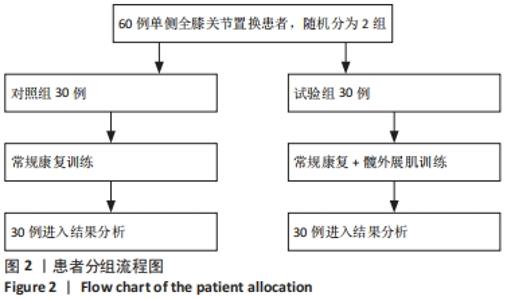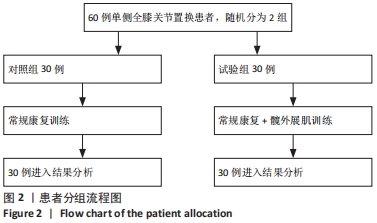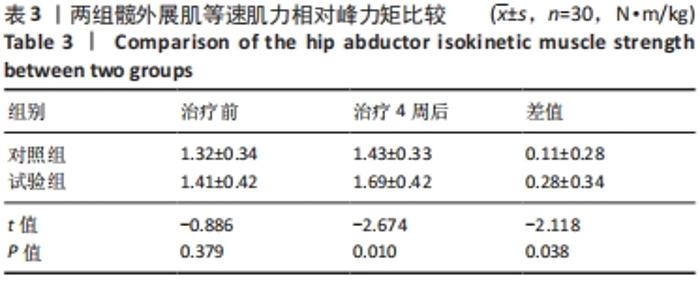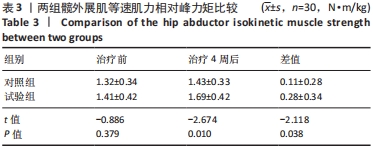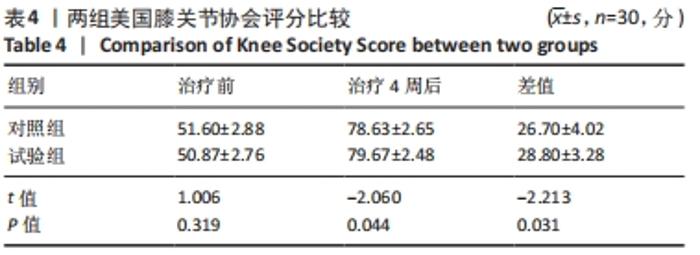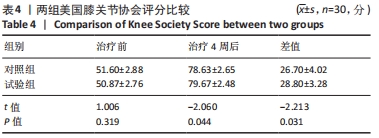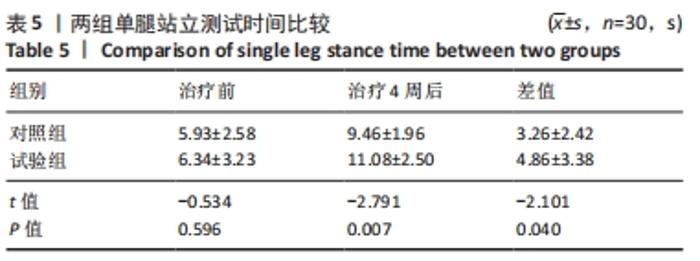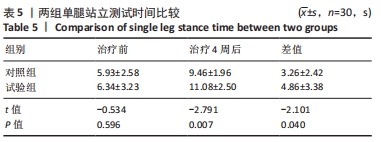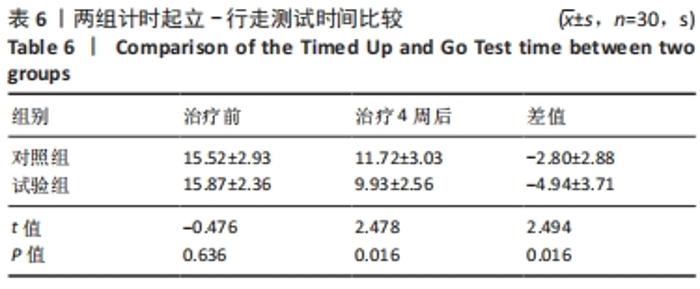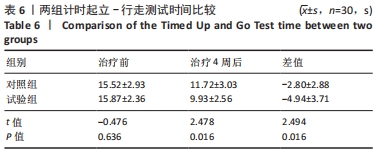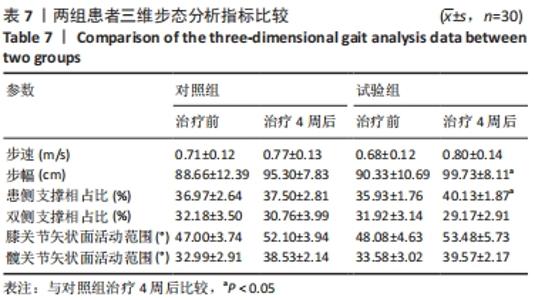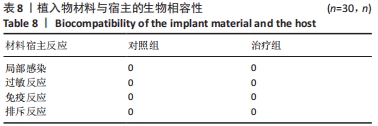Chinese Journal of Tissue Engineering Research ›› 2022, Vol. 26 ›› Issue (33): 5311-5316.doi: 10.12307/2022.725
Previous Articles Next Articles
Early hip abductor training to improve balance and walking ability after total knee arthroplasty
Quan Honglei1, Zheng Jiejiao1, 2, Feng Youyan1, Zhang Jie2, Zhu Yinghui1
- 1Shanghai University of Traditional Chinese Medicine, Shanghai 201203, China; 2Huadong Hospital Affiliated to Fudan University, Shanghai 200040, China
-
Received:2021-09-30Accepted:2021-11-17Online:2022-11-28Published:2022-03-30 -
Contact:Zheng Jiejiao, Professor, Shanghai University of Traditional Chinese Medicine, Shanghai 201203, China; Huadong Hospital Affiliated to Fudan University, Shanghai 200040, China -
About author:Quan Honglei, Master candidate, Shanghai University of Traditional Chinese Medicine, Shanghai 201203, China -
Supported by:National Key Research and Development Program, No. 2020YFC2008700 (to ZJJ); Shanghai Rehabilitation Medicine Clinical Research Center, No. 21MC1930200 (to ZJJ)
CLC Number:
Cite this article
Quan Honglei, Zheng Jiejiao, Feng Youyan, Zhang Jie, Zhu Yinghui. Early hip abductor training to improve balance and walking ability after total knee arthroplasty[J]. Chinese Journal of Tissue Engineering Research, 2022, 26(33): 5311-5316.
share this article
Add to citation manager EndNote|Reference Manager|ProCite|BibTeX|RefWorks
| [1] 帖小佳,郑如庚,赵梦, 等. 中国中老年人膝关节骨关节炎患病率的Meta分析[J]. 中国组织工程研究,2018,22(4):650-656. [2] 刘朝晖,马剑雄,张顺, 等. 膝骨关节炎的现状及治疗方法的研究进展[J]. 中华骨与关节外科杂志,2020,13(8):688-693. [3] INACIO MCS, PAXTON EW, GRAVES SE, et al. Projected increase in total knee arthroplasty in the United States-an alternative projection model. Osteoarthritis Cartilage. 2017;25(11):1797-1803. [4] POZZI F, WHITE DK, SNYDER-MACKLER L, et al. Restoring physical function after knee replacement: a cross sectional comparison of progressive strengthening vs standard physical therapy. Physiother Theory Pract. 2020;36(1):122-133. [5] DO K, YIM J. Effects of Muscle Strengthening around the Hip on Pain, Physical Function, and Gait in Elderly Patients with Total Knee Arthroplasty: A Randomized Controlled Trial. Healthcare (Basel). 2020; 8(4):489. [6] BADE MJ, KOHRT WM, STEVENS-LAPSLEY JE. Outcomes before and after total knee arthroplasty compared to healthy adults. J Orthop Sports Phys Ther. 2010;40:559-567. [7] JUNKER D, STÖGGL T. The Training Effects of Foam Rolling on Core Strength Endurance, Balance, Muscle Performance and Range of Motion: A Randomized Controlled Trial. J Sports Sci Med. 2019;18(2): 229-238. [8] LOYD BJ, JENNINGS JM, JUDD DL, et al. Influence of Hip Abductor Strength on Functional Outcomes Before and After Total Knee Arthroplasty: Post Hoc Analysis of a Randomized Controlled Trial. Phys Ther. 2017;97(9):896-903. [9] YUENYONGVIWAT V, DUANGMANEE S, IAMTHANAPORN K, et al. Effect of hip abductor strengthening exercises in knee osteoarthritis: a randomized controlled trial. BMC Musculoskelet Disord. 2020;21(1): 284. [10] BENNELL KL, HUNT MA, WRIGLEY TV, et al. Hip strengthening reduces symptoms but not knee load in people with medial knee osteoarthritis and varus malalignment: a randomised controlled trial. Osteoarthr Cartil. 2010; 18(5): 621-628. [11] RAGHAVA NEELAPALA YV, BHAGAT M, SHAH P. Hip Muscle Strengthening for Knee Osteoarthritis: A Systematic Review of Literature. J Geriatr Phys Ther. 2020;43(2):89-98. [12] D’AMATO M, KOSSE NM, WYMENGA AB. Restoration of pre-operative joint line orientation and alignment does not affect KSS and KOOS 1 year after total knee arthroplasty. Knee Surg Sports Traumatol Arthrosc. 2021;29(10):3170-3177. [13] GHISLIERI M, KNAFLITZ M, LABANCA L, et al. Muscle Synergy Assessment During Single-Leg Stance. IEEE Trans Neural Syst Rehabil Eng. 2020; 28(12):2914-2922. [14] BROWNE W, NAIR BKR. The Timed Up and Go test. Med J Aust. 2019; 210(1):13-14. [15] ESPINOSA SE, COSTELLO KE, SOUZA RB, et al. Lower knee extensor and flexor strength is associated with varus thrust in people with knee osteoarthritis. J Biomech. 2020;107:109865. [16] JUDD DL, ECKHOFF DG, STEVENS-LAPSLEY JE. Muscle strength loss in the lower limb after total knee arthroplasty. Am J Phys Med Rehabil. 2012; 91(3):220-226;quiz 227-230. [17] PALMER K, HEBRON C, WILLIAMS JM. A randomised trial into the effect of an isolated hip abductor strengthening programme and a functional motor control programme on knee kinematics and hip muscle strength. BMC Musculoskeletal Disorders. 2015;16:105. [18] INACIO M, RYAN AS, BAIR WN, et al. Gluteal muscle composition differentiates fallers from non-fallers in community dwelling older adults. BMC Geriatr. 2014;14: 37. [19] ROGERS MW, CREATH RA, GRAY V, et al. Comparison of Lateral Perturbation-Induced Step Training and Hip Muscle Strengthening Exercise on Balance and Falls in Community-Dwelling Older Adults: A Blinded Randomized Controlled Trial. J Gerontol A Biol Sci Med Sci. 2021;76(9):e194-e202. [20] MARTINS PP, PORTO JM, VIEIRA FT, et al. The effect of unilateral muscle fatigue of hip abductor muscles on balance and functional capacity in community-dwelling older women. Arch Gerontol Geriatr. 2020;91: 104222. [21] GAFNER SC, BASTIAENEN CHG, BIVER E, et al. Reliability and validity of an adapted hip abductor strength measure as a potential new fall risk assessment for older persons: a study protocol. BMC Geriatr. 2021; 21(1):110. [22] 周甜甜,安丙辰,郑洁皎.髋关节肌康复训练治疗膝骨关节炎机制的研究进展[J].中国康复理论与实践,2019,25(12):1414-1417. [23] SCHACHE MB, MCCLELLAND JA, WEBSTER KE, et al. Does the addition of hip strengthening exercises improve outcomes following total knee arthroplasty? A study protocol for a randomized trial. BMC Musculoskelet Disord. 2016;17:259. [24] KVARDA P, NÜESCH C, EGLOFF C. Hip abductor muscle strength in patients after total or unicompartmental knee arthroplasty for knee osteoarthritis or avascular necrosis: a systematic review and meta-analysis protocol. BMJ Open. 2020;10(8):e038770. [25] IWATA A, SANO Y, WANAKA H, et al. Different improvement trends in gait function and quadriceps strength early after total knee arthroplasty. J Phys Ther Sci. 2019;31(1):57-62. [26] THORP LE, WIMMER MA, FOUCHER KC, et al. The biomechanical effects of focused muscle training on medial knee loads in OA of the knee: a pilot, proof of concept study. J Musculoskelet Neuronal Interact. 2010; 10(2):166-173. [27] HOGLUND LT, PONTIGGIA L, KELLY JD. A 6-week hip muscle strengthening and lumbopelvic-hip core stabilization program to improve pain, function, and quality of life in persons with patellofemoral osteoarthritis:a feasibility pilot study. Pilot Feasibility Stud. 2018;4:70. [28] LEE SP, SOUZA RB, POWERS CM. The influence of hip abductor muscle performance on dynamic postural stability in females with patellofemoral pain. Gait Posture. 2012;36(3):425-429. [29] PAPA EV, FOREMAN KB, DIBBLE LE. Effects of age and acute muscle fatigue on reactive postural control in healthy adults. Clin Biomech (Bristol,Avon). 2015;30(10):1108-1113. [30] KAWADA M, TAKESHITA Y, MIYAZAKI T, et al. Contribution of hip and knee muscles to lateral knee stability during gait. J Phys Ther Sci. 2020; 32(11):729-734. [31] IIJIMA H, YOROZU A, SUZUKI Y, et al. Hip abductor muscle weakness and slowed turning motion in people with knee osteoarthritis. J Biomech. 2020;101:109652. [32] ALNAHDI AH, ZENI JA, SNYDER-MACKLER L. Hip abductor strength reliability and association with physical function after unilateral total knee arthroplasty: a cross-sectional study. Phys Ther. 2014;94(8): 1154-1162. [33] PIVA SR, TEIXEIRA PE, ALMEIDA GJ, et al. Contribution of hip abductor strength to physical function in patients with total knee arthroplasty. Phys Ther. 2011;91(2):225-233. [34] BĄCZKOWICZ D, SKIBA G, CZERNER M, et al. Gait and functional status analysis before and after total knee arthroplasty. Knee. 2018; 25(5):888-896. [35] 黄萍,陈博,刘志宏,等.膝关节置换后患者的三维步态特征[J].中国组织工程研究,2018,22(35):5596-5601. [36] 徐瑞,王中汉,马廷健,等.三维步态捕捉技术辅助分析膝关节炎患者运动功能改变[J].临床医药文献电子杂志,2019,6(50):57+60. [37] SUN M, ZHANG Y, PENG Y, et al. Gait Analysis after Total Knee Arthroplasty Assisted by 3D-Printed Personalized Guide. Biomed Res Int. 2020:6485178. [38] ARVIN M,HOOZEMANS MJ, BURGER BJ, et al. Effects of hip abductor muscle fatigue on gait control and hip position sense in healthy older adults. Gait Posture. 2015;42(4):545-549. |
| [1] | Wang Shuai, Wang Liancheng, Zhang Shuhao, Li Fuli, Dong Jiaxing, Zhang Yajie. Correlation of the electromyography ratio of the paraspinal muscles on the convex and concave sides with Cobb angle, apical vertebra translation, and coronal balance distance in adolescent idiopathic scoliosis patients [J]. Chinese Journal of Tissue Engineering Research, 2022, 26(9): 1402-1406. |
| [2] | Yu Chengxiang, Liu Lehong, Li Wenbo, Chen Jinshi, Ran Chunlei, Wang Zhongping. Correlation between spine-pelvic sagittal parameters and prognosis of vertebroplasty in the treatment of thoracolumbar osteoporotic vertebral compression fractures [J]. Chinese Journal of Tissue Engineering Research, 2022, 26(9): 1412-1417. |
| [3] | Li Jian, Bao Zhengqi, Zhou Pinghui, Zhu Ruizhi, Li Zhixiang, Wang Jinzi. Effects of posterior single open-door laminoplasty and anterior cervical corpectomy fusion on cervical sagittal balance parameters in the treatment of multilevel cervical spondylotic myelopathy [J]. Chinese Journal of Tissue Engineering Research, 2022, 26(6): 949-953. |
| [4] | Huang Hao, Hong Song, Wa Qingde. Finite element analysis of the effect of femoral component rotation on patellofemoral joint contact pressure in total knee arthroplasty [J]. Chinese Journal of Tissue Engineering Research, 2022, 26(6): 848-852. |
| [5] | Yuan Jing, Sun Xiaohu, Chen Hui, Qiao Yongjie, Wang Lixin. Digital measurement and analysis of the distal femur in adults with secondary knee valgus deformity [J]. Chinese Journal of Tissue Engineering Research, 2022, 26(6): 881-885. |
| [6] | Zhou Jianguo, Liu Shiwei, Yuan Changhong, Bi Shengrong, Yang Guoping, Hu Weiquan, Liu Hui, Qian Rui. Total knee arthroplasty with posterior cruciate ligament retaining prosthesis in the treatment of knee osteoarthritis with knee valgus deformity [J]. Chinese Journal of Tissue Engineering Research, 2022, 26(6): 892-897. |
| [7] | Wang Nan, Qian Yuzhang, Xie Lin. Network Meta-analysis of different acupuncture methods for the treatment of lumbar disc herniation [J]. Chinese Journal of Tissue Engineering Research, 2022, 26(5): 813-820. |
| [8] | Yin Yikun, Wang Jialin, Wu Chaoming, Sun Junzhi. Joint mobilization treatment for chronic ankle instability function recovery: a meta-analysis [J]. Chinese Journal of Tissue Engineering Research, 2022, 26(33): 5407-5412. |
| [9] | Liu Jinlei, Yin Li, Zhang Yi, Wang Haitao, Lu Yingzi. Intra-articular tranexamic acid at different volumes and doses affects blood loss during total knee arthroplasty [J]. Chinese Journal of Tissue Engineering Research, 2022, 26(33): 5303-5310. |
| [10] | Song Wei, Zhang Yaxin, Jia Dazhou, Sun Yu. Adjective application of dexamethasone combined with furosemide for early pain and swelling after total knee arthroplasty [J]. Chinese Journal of Tissue Engineering Research, 2022, 26(33): 5317-5322. |
| [11] | Pan Hao, Zhao Huihui, Wang Jiangjing, Wang Feng, Wang Peng, Shi Qiuling, Guo Jin, Li Lin, Liu Guoqiang. Comparison of kinematic alignment and mechanical alignment to guide gait after total knee arthroplasty [J]. Chinese Journal of Tissue Engineering Research, 2022, 26(3): 365-370. |
| [12] | Qu Pengfei, Wang Huisheng, Li Xi. Correlation between blood loss during primary total knee arthroplasty and hypoalbuminemia and hypocalcemia after arthroplasty [J]. Chinese Journal of Tissue Engineering Research, 2022, 26(3): 376-382. |
| [13] | Qiao Qiqi, Wu Yixin, Wang Xin, Xia Zhongliang. Effect of high-definition transcranial direct current stimulation on human dynamic balance [J]. Chinese Journal of Tissue Engineering Research, 2022, 26(26): 4192-4198. |
| [14] | Li Zhishuai, Zhang Hongqian, Liu Jianquan, Zhang Hankun, Li Li. Visualization analysis of current research hotspots on rehabilitation treatment after anterior cruciate ligament reconstruction [J]. Chinese Journal of Tissue Engineering Research, 2022, 26(26): 4234-4241. |
| [15] | Liu Fatai, Yang Jinshun, Zhong Weibin. Application of three-dimensional printed osteotomy guide plate in knee arthroplasty in osteoarthritis patients with concomitant femoral deformity [J]. Chinese Journal of Tissue Engineering Research, 2022, 26(15): 2312-2316. |
| Viewed | ||||||
|
Full text |
|
|||||
|
Abstract |
|
|||||
